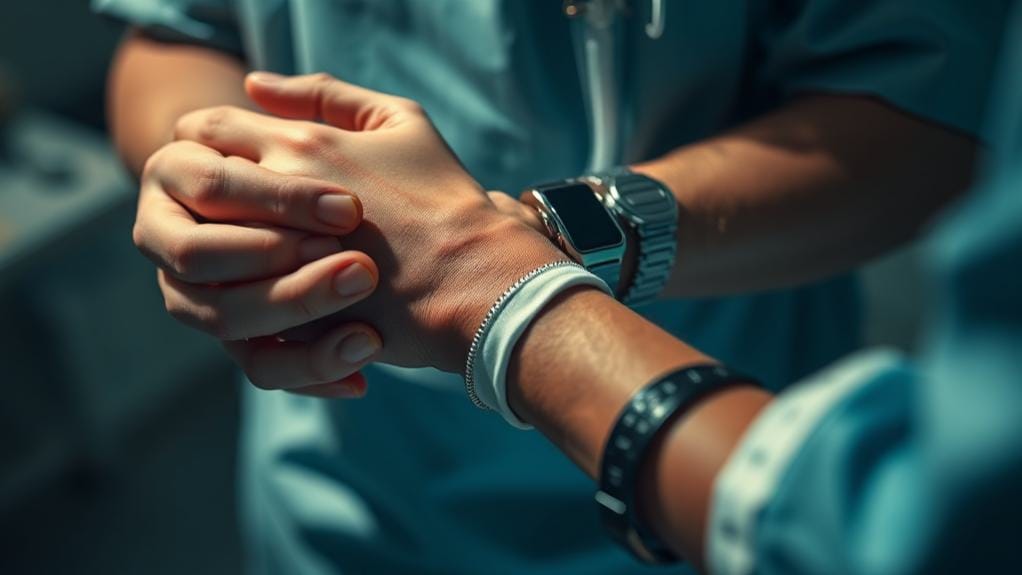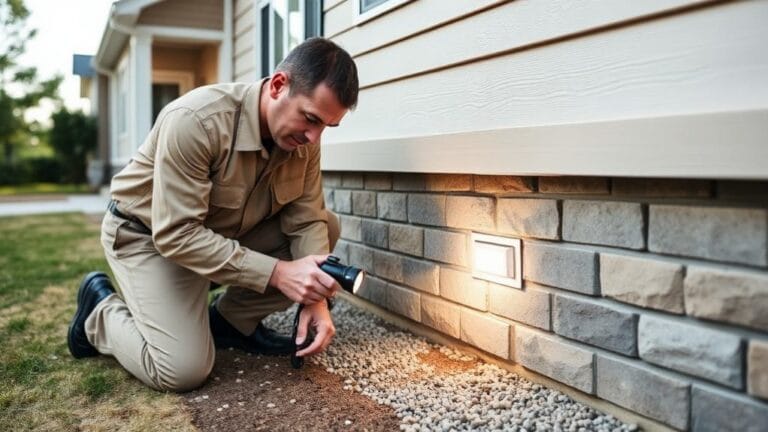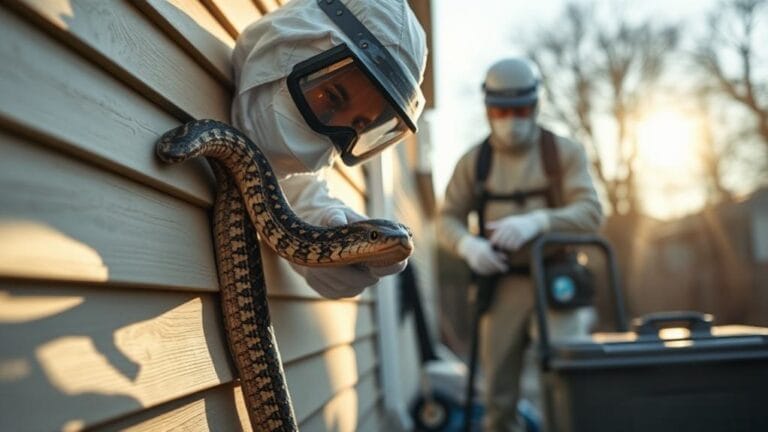If you're dealing with a snake bite, act fast! First, call 911 and get away from the snake. Keep the victim calm and lying down – panic's not your friend here. Remove any tight items like jewelry or clothing near the bite site. Clean the wound gently (but skip this for venomous bites). Position the bitten area below heart level and keep the victim still. Monitor essential signs every 15 minutes and apply a sterile bandage. Track all symptoms and changes carefully. And please, no Hollywood-style snake-bite remedies – they'll do more harm than good. There's more to proper snake bite care than meets the eye.
Call Emergency Services
Table of Contents
Immediately calling 911 is the most critical first step when dealing with a snake bite. Don't try to be a hero – this isn't the time to Google home remedies or ask your cousin what to do.
While some people rely on natural snake deterrents to prevent encounters, professional medical care is essential once a bite occurs. Call emergency services right away. Every second counts!
When you call 911:
- Tell them it's a snake bite emergency (yeah, that gets their attention)
- Describe the snake if you saw it – color, pattern, size (but don't chase it for a better look!)
- Share the victim's condition and symptoms
- Give your exact location
- Stay on the line – they'll tell you what to do next
*Pro Tip: If you think it's a venomous snake, say so. The hospital needs to prep antivenom, and trust me, you don't want them caught off guard.*
Move Away From Snake

Once you've called 911, your next priority is getting to a safe distance from the snake. Move calmly but deliberately – this isn't the time to show off your dancing skills. Remember: a panicked sprint might just provoke another strike.
| Do This | Don't Do This |
|---|---|
| Back away slowly | Run frantically |
| Keep eyes on snake | Turn your back |
| Stay calm & quiet | Make sudden moves |
| Note snake features | Try to catch it |
Once you're at a safe distance, I need you to focus on keeping still. The more you move, the faster that venom will spread through your system. Yeah, I know it's tempting to chase that snake for a selfie, but let's prioritize keeping you alive.
*Pro Tip: Try to remember the snake's appearance for medical staff – but don't risk another bite just to get a better look.*
Keep Victim Calm

The next crucial step can literally save a life – keeping the bite victim calm. Trust me, panic is the last thing you want because it speeds up the spread of venom through the bloodstream. Yeah, that's as bad as it sounds.
While you wait, consider using natural snake deterrents like mint or peppermint plants around your property to prevent future encounters.
Here's what you need to do:
- Get them to lie down comfortably (no, the fetal position won't help)
- Guide their breathing – slow and deep, like they're at a meditation retreat
- Keep reassuring them that help is coming
- Monitor their essential signs without looking freaked out yourself
Pro tip: Your calm demeanor is contagious. If you're acting like it's just another Tuesday, they're more likely to stay relaxed too.
Remember: A calm victim = slower venom spread. It's that simple. Your job is to be their emotional rock until medical help arrives.
Remove Constricting Items

Like many skilled hunting breeds, quick action and proper technique are essential when treating snake bites.
While keeping the victim calm, you'll need to tackle another time-sensitive task. It's time to remove constricting items before swelling turns those accessories into tourniquets – and trust me, that's not a fashion statement anyone wants to make.
Get those items off ASAP:
- Rings, watches, and jewelry
- Tight clothing near the bite
- Anything that could restrict blood flow
Here's the tricky part: Don't press or squeeze while removing these items. That'll just make the swelling worse – because apparently, that's exactly what we don't need right now.
Pro tip: Keep all removed items nearby. The medical care team might need to see them, and they'll appreciate not having to play a scavenger hunt while treating a snakebite victim.
Monitor the area closely for swelling after removal. Changes in color or size? Make note of it.
Clean The Wound

Cleaning a snake bite wound requires a delicate balance between proper sanitization and preserving essential medical evidence.
Here's the significant part about wound care – if you're dealing with a non-venomous snake bite, gently clean the area with soap and water. And I mean gently. This isn't the time to show off your scrubbing skills! Just remove visible dirt and debris without going overboard.
While professional assistance is always recommended for snake encounters, immediate wound care may be necessary.
But wait! If you suspect it's a venomous snake bite, keep those cleaning supplies away. Yes, you heard that right. Don't wash the bite area. Those venom traces could be critical information for the medical team – they're kind of important for, you know, saving your life.
Pro tip: Skip the fancy antiseptics and ointments. They'll just mess with proper medical evaluation.
Cover the cleaned wound with a sterile dressing and watch for infection signs.
Document Snake Appearance

With your bite wound properly addressed, let's focus on something that could save precious time in the emergency room – documenting what the snake looked like.
Trust me, medical staff will want details about the snake that just turned your day upside down. Different species of snakes mean different types of snake venom, so your observations matter!
| What to Document | Why It Matters |
|---|---|
| Head Shape | Triangular = Usually Venomous |
| Color/Patterns | Helps ID the Species |
| Size | Affects Venom Amount |
| Special Features | Rattles? Bands? |
| Location Found | Narrows Down Species |
*Pro Tip: Take a photo of the snake if it's safe to do so – but don't try to catch it or become its second victim of the day. The ER doesn't need two snake bite patients!*
Maintain Proper Body Position

After securing immediate first aid, proper body positioning becomes your next crucial task. Look, gravity isn't your friend when venom's involved, so let's get this right.
While snake-proof fencing solutions can prevent bites in the first place, knowing proper positioning is essential for emergencies.
Here's what you need to do (and yes, it's really this simple):
- Get the victim lying down flat – no heroic standing around like it's just a paper cut
- Keep the bitten limb at or below heart level for pressure immobilization
- Tell them to stay still – this isn't the time for interpretive dance
Pro tip: A calm victim is a better-off victim. Less movement = less venom circulation = better outcome.
Your job is to slow the spread of venom while waiting for medical help. Keep them comfortable and monitor their critical signs.
Don't let them get up and wander around – I don't care if they swear they're feeling fine.
Monitor Vital Signs

While keeping the victim still and properly positioned, your attention must shift to monitoring their crucial signs. I'll tell you what to watch – and trust me, you don't want to miss anything here.
| Time Since Bite | What to Check | Warning Signs |
|---|---|---|
| Every 15 min | Pulse rate | Racing/weak |
| Every 15 min | Breathing | Shallow/rapid |
| Every 30 min | Skin color | Pale/bluish |
| Continuous | Swelling | Spreading |
Monitor crucial signs constantly – this isn't a time to get lazy! Track everything you observe and note the exact times. Your healthcare provider will need this info. Watch for allergic reactions like hives or breathing trouble. Keep checking the bite area for changes in color or swelling. And please, don't play hero – if anything looks scary, call emergency services immediately.
*Pro Tip: Use your phone to take timestamped photos of the bite area's progression.*
Apply Sterile Bandage

Securing a proper bandage requires careful attention to prevent complications. Don't even think about applying ice to those puncture wounds – that's a recipe for disaster.
You'll want to keep that bandage loose enough to allow for swelling but clean enough to ward off infection.
- Cover the bite site with a sterile dressing – and no, your old t-shirt doesn't count as sterile.
- Keep the bandage loose (seriously, don't play tourniquet hero here).
- Monitor the area like a hawk for any changes in color or temperature.
*Pro tip: If you're dealing with a venomous snake, I'll let you in on a secret – pressure bandages are only helpful during transport, and even then, not for pit viper bites. Keep that bitten limb below heart level while you're at it.*
Record Symptom Changes

Now that you've got that bandage sorted, let's focus on tracking every detail of your symptoms. Trust me – this isn't the time to play tough. Write down everything.
Keep tabs on:
- Swelling and pain levels (yeah, they matter)
- Skin color changes around the bite
- Your heart rate and breathing (count them!)
- Any signs of allergic reaction like hives or wheezing
- The exact time the bite happened
Pro tip: Your phone's notes app works great for this – if you can still use your fingers.
Watch out for the nasty stuff too:
- Nausea or vomiting
- Confusion or dizziness
- Pus or unusual warmth near the bite
- Trouble breathing
Remember: Doctors need this info to save your behind, so be thorough. Every detail counts.
Frequently Asked Questions
How to First Aid a Snake Bite?
I'll call 911 right away while keeping you calm and still. I won't apply ice or tourniquets. I'll position the bite below your heart, note the snake's appearance, and monitor you until help arrives.
What Are the 7 Principles of Snake Bite Management?
I'll tell you the absolute most critical snake bite principles! Call 911 immediately, immobilize the limb, identify the snake, avoid harmful actions like cutting, monitor for shock, keep calm, and seek medical care fast.
What Is the First Aid Scenario for Snake Bite?
If I find a snakebite victim, I'll call 911 immediately, keep them calm and still, immobilize the affected limb below heart level, and monitor their symptoms while waiting for emergency medical help.
What Steps Should Be Taken if You Encounter a Snake?
I'd love meeting a snake, but here's what you'll want to do: Stay calm, back away slowly while watching it, avoid sudden moves, and remember its appearance. Don't provoke or corner it.
Last Word
Snake bites can kill you faster than you can say "why didn't I watch where I was stepping?" I've shared these critical first aid steps because they're literally the difference between life and death. While you're waiting for help to arrive, staying calm and following these steps precisely will be your lifeline. Remember: I can teach you snake bite first aid all day, but your best move is still avoiding the snake in the first place.








